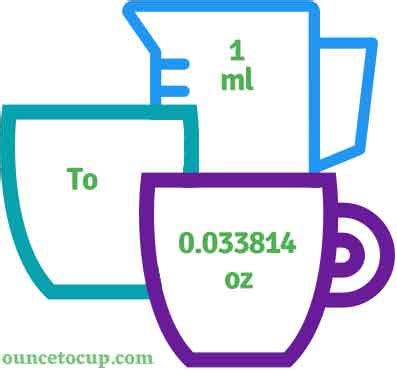How to Convert 110 ml to Oz

When it comes to converting volumes, especially between different measurement systems like the metric system and the imperial system, it's important to have accurate conversion factors. In this article, we will delve into the process of converting 110 milliliters (ml) to ounces (oz), a common task for those working in various industries, from cooking and baking to scientific research.
Understanding the Conversion Factor

To convert between milliliters and ounces, we need to be familiar with the conversion factor that relates these two units of volume. The conversion factor for milliliters to ounces is approximately 0.033814, which means that one milliliter is equivalent to approximately 0.033814 ounces. This factor allows us to accurately convert between the two units.
It's important to note that this conversion factor is an approximation, as the exact conversion depends on the definition of the ounce. In this case, we are referring to the US fluid ounce, which is commonly used in everyday measurements and cooking.
Converting 110 ml to Oz: Step by Step

Now, let’s apply this conversion factor to convert 110 milliliters to ounces. Follow these simple steps:
Step 1: Apply the Conversion Factor
Multiply the volume in milliliters by the conversion factor. In this case, we have:
110 ml * 0.033814 oz/ml = 3.71954 oz
So, the approximate conversion for 110 milliliters is 3.71954 ounces.
Step 2: Rounding the Result
In most cases, you’ll want to round the result to a reasonable number of decimal places for practical purposes. Rounding to two decimal places, our conversion would be:
110 ml = 3.72 oz
Thus, 110 milliliters is approximately equal to 3.72 ounces.
Step 3: Understanding the Precision
It’s crucial to consider the precision and accuracy of the conversion. In this case, the conversion factor is an approximation, and the result may vary slightly depending on the specific definition of the ounce. For most practical purposes, the rounded value of 3.72 ounces is sufficient.
Real-World Applications
Converting between milliliters and ounces is a common task in various fields. Here are a few real-world scenarios where this conversion is useful:
- Cooking and Baking: Many recipes, especially those originating from countries using the imperial system, provide ingredient quantities in ounces. If you have a metric measuring device, you can easily convert the ounce measurement to milliliters for accurate cooking.
- Pharmaceuticals: In the pharmaceutical industry, it's essential to precisely measure and dispense medications. Converting between milliliters and ounces allows healthcare professionals to ensure the correct dosage is administered.
- Scientific Research: Researchers often need to convert between different units of measurement when analyzing data or conducting experiments. Accurate conversion factors are crucial for maintaining the integrity of scientific studies.
- International Trade: When trading goods internationally, especially in the food and beverage industry, it's common to encounter products labeled in ounces. Converting these measurements to milliliters helps businesses ensure accurate packaging and labeling.
Accuracy and Precision in Conversions
Maintaining accuracy and precision in volume conversions is vital. Inaccurate conversions can lead to errors in various fields, from cooking to scientific research. Here are some tips to ensure precise conversions:
- Use reliable conversion factors obtained from reputable sources or scientific references.
- Understand the specific definitions of the units you are converting, such as the US fluid ounce or the UK fluid ounce, as they can have slightly different values.
- Consider the precision required for your specific application. In some cases, you may need to use more precise conversion factors or round the result to a higher number of decimal places.
- If dealing with large volumes or critical applications, consider using conversion tools or software that provide accurate and instant conversions.
The Importance of Standardization

Standardization of measurement units is crucial for consistency and clarity in various industries. While the metric system is widely adopted internationally, the imperial system is still prevalent in certain regions, particularly in the United States. This coexistence of measurement systems often requires conversions like the one we’ve discussed.
Standardization efforts, such as the adoption of the International System of Units (SI), aim to simplify and unify measurement systems worldwide. However, until full standardization is achieved, accurate conversions like milliliters to ounces will remain essential for effective communication and collaboration across different regions and industries.
Conclusion
Converting 110 milliliters to ounces is a straightforward process when using the appropriate conversion factor. By following the steps outlined in this article, you can accurately convert volumes between these two units. Remember to consider the precision and accuracy required for your specific application, and always use reliable conversion factors to ensure the best results.
Frequently Asked Questions
What is the exact conversion factor for milliliters to ounces?
+The exact conversion factor for milliliters to US fluid ounces is 0.033814, as defined by the US National Institute of Standards and Technology (NIST). This factor is an exact conversion based on the definitions of the units.
Are there different conversion factors for UK fluid ounces?
+Yes, the conversion factor for milliliters to UK fluid ounces is different. The exact conversion factor is 0.028413, which is based on the UK’s definition of the fluid ounce. It’s important to use the appropriate conversion factor for the specific ounce definition you are working with.
How precise should I be when converting milliliters to ounces for cooking recipes?
+For cooking recipes, a reasonable level of precision is often sufficient. Rounding the conversion to one or two decimal places is generally acceptable. However, for critical recipes or those requiring precise measurements, it’s best to use a more precise conversion factor and round the result accordingly.



